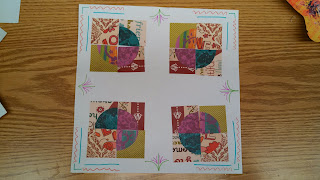I, personally, really enjoyed this project. This lesson was introduced by discussing patterns and differences between various simple shapes, etc. This project allowed us to be creative and incorporate other subject areas into this simple, yet fun activity. This is ideal for younger students, but can also be broadened and more detailed for use with older grades.
Instructions:
1. We were provided with paper plates that had large squares already traced onto it.
2. Each student determined which three basic geometric shapes we wanted to incorporate to create the pattern within the squares of the paper plate. We practiced these first on scratch paper before drawing them on the actual paper plate.
3. We then drew and colored in the pattern we selected for our own plate.
4. Next, we completed the remainder of the fish by coloring in the rest of the paper plate in a design we created.
5. We cut out a mouth for the fish and used the cutout for the mouth as a fin on the fish. We then drew on gills and added eyes to complete our project.
6. The teacher added fishing line so that we would be able to hang and display our own individual fish.














